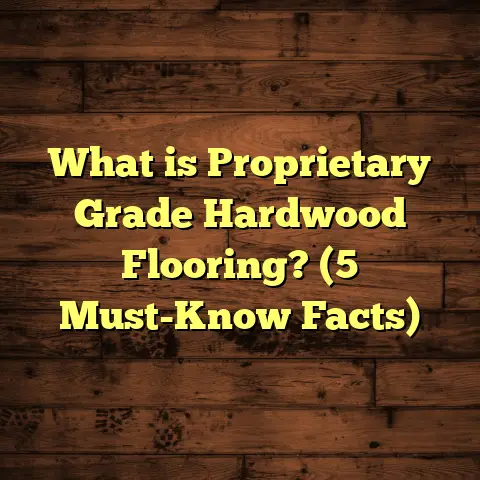What is Floor Prep? (5 Essential Tips for Perfect Finishing)
I’ve always had a soft spot for pets—dogs, cats, you name it. The way they bring life and warmth into a home is unmatched. But if you’ve ever had animals running around your house, you know how floors can take a beating. Scratches from claws, dirt and mud tracked in from outside, and sometimes those little accidents that every pet owner dreads. When I step into a flooring project for a client with pets, I immediately think about how to make sure their new floors don’t just look amazing but also hold up over time. That’s where floor prep comes in.
You might be wondering: what exactly is floor prep? Why does it matter so much especially if you have pets? And how can you do it right without spending endless hours or money? I’m here to walk you through everything I’ve learned after years in the flooring business—helping both pet owners and regular homeowners get floors that last and shine.
What is Floor Prep?
Floor prep is the foundation of any successful flooring installation. It’s everything you do to get the surface ready before laying down your new flooring material—whether hardwood, laminate, vinyl, tile, or carpet.
I like to think of floor prep as setting the stage for a performance. If the stage isn’t steady or clean, no matter how great the actors are, the show will suffer.
This preparation process typically includes:
- Cleaning: Removing all dust, debris, grease, and any substances that might cause adhesion problems.
- Leveling: Making sure the subfloor is perfectly flat and smooth to avoid bumps or dips.
- Repairing: Fixing cracks, holes, loose boards, or damaged areas.
- Moisture Testing: Checking moisture levels that could damage certain flooring types.
- Installing Underlayment: Adding layers like foam or cork that provide cushioning and soundproofing.
Each of these steps might sound simple on paper but can get tricky in practice—especially when pets have been around leaving hair and scratches or when old floors have hidden damage.
The Importance of Floor Prep
Let me share a story from early in my career. I worked on a beautiful hardwood floor installation for a family with two German Shepherds. The dogs loved running through the living room and often tracked in dirt after walks. The homeowners were excited about their new floors but didn’t realize how moisture trapped underneath an old subfloor could cause warping.
We skipped some of the moisture testing steps due to time constraints (a mistake I regret). Within six months, parts of the hardwood started to cup and buckle. The clients were understandably upset—it was a costly fix and mess.
That experience taught me something vital: no matter how high-quality your flooring material is, if you don’t prepare the base properly, you risk failure. Skimping on floor prep is one of the main reasons flooring projects go wrong.
Statistics back this up. According to the Flooring Contractors Association, roughly 60% of flooring failures stem from poor floor preparation. That includes uneven surfaces, moisture issues, dirt contamination, or inadequate repairs.
5 Essential Tips for Perfect Floor Prep
I want to share five essential tips that I follow in every floor prep project. These tips come from hands-on experience and industry best practices—and they’ll help you avoid headaches and get floors that look fantastic for years.
1. Start With Thorough Cleaning — Don’t Underestimate This Step
Before doing anything else, cleaning is your first priority. You might think this is obvious but trust me—I’ve seen installers rush through this step and face problems later.
If you have pets like I do, you know how much fur and dander can accumulate even if you vacuum regularly. Dirt and grease might be invisible but can interfere with adhesives or leveling compounds.
What do I do?
I sweep and vacuum the entire area multiple times. Then I mop with a gentle cleaner that doesn’t leave any residue. For stubborn grease or sticky spots, I use a degreaser designed for floors. If there’s old adhesive residue from previous flooring, I scrape or sand it off carefully.
Why does this matter?
Studies show that even tiny amounts of dust reduce adhesive strength by up to 40% (Adhesive Research Institute). That’s huge! Imagine your expensive vinyl or hardwood not sticking properly because of some unseen dirt.
If you need extra assurance, wait until the floor is completely dry before moving forward.
2. Check Moisture Levels — Don’t Let Water Sneak In
Moisture can wreck floors silently over time. It causes wood to warp, laminate planks to swell, and tiles to crack loose from their glue.
I always test moisture content with a reliable moisture meter before starting any installation involving wood, laminate, vinyl, or tile over concrete slabs.
Here’s what I look for:
- Concrete slabs should be below 3 pounds per 1000 square feet over 24 hours (using calcium chloride test) or under 4% moisture content (using in-situ probes).
- Wood subfloors generally need moisture content under 12%.
If moisture is too high, I install vapor barriers like polyethylene sheets or sealants before proceeding.
A story from the field:
A client wanted laminate installed in their basement without moisture testing. Within months, they faced buckling and mold underneath due to groundwater seepage. It was an expensive fix they didn’t expect.
By contrast, on another project with proper testing and vapor barriers in place, the floors stayed perfect for over five years despite heavy foot traffic and pets.
According to the National Wood Flooring Association, moisture testing reduces repair costs by 30-50%, saving thousands in future expenses.
3. Level Your Subfloor — Smoothness Is Key
Uneven or bumpy subfloors are a nightmare for installers and homeowners alike.
I use a laser level or straightedge to check for dips or high spots across the entire floor area before installation.
If deviations exceed 3/16 inch over 10 feet, I apply leveling compounds or self-leveling underlayments for concrete slabs. For wood subfloors, sanding low spots and shimming high ones helps create a flat surface.
Why does this matter?
Uneven floors cause squeaking hardwoods, cracked tiles, bubbles in vinyl, and gaps in laminate.
From my experience working on hundreds of homes, leveling your subfloor precisely can mean the difference between floors that last 5 years versus 20+ years without issues.
One memorable project involved an old farmhouse with seriously uneven wooden flooring underneath. After careful leveling and reinforcement, the new hardwood floors looked stunning and have held up beautifully for more than 10 years now.
4. Repair All Damage — Don’t Cover Up Problems
Missing boards, cracks, holes—these need attention before installing new floors.
In one older home I worked on recently, termite damage had weakened several floor joists beneath an old hardwood floor. Catching this early meant we could replace damaged supports rather than just covering them with new flooring—which would have been dangerous and costly later on.
Use wood filler or patching compounds for small holes and cracks. Replace any severely damaged boards or sections of subfloor before moving forward.
Loose boards can cause annoying squeaks after installation if left untreated.
I often tell clients: “Don’t just cover up problems; fix them properly.” It saves time and money in the long run.
5. Choose Underlayment Wisely — It Makes a Big Difference
Underlayment isn’t just an extra layer; it offers cushioning, soundproofing, moisture protection, and comfort—especially important if pets are part of your household.
For laminate or engineered hardwood floors over concrete slabs or noisy surfaces, I recommend foam or cork underlayments with good density (minimum 1/4 inch thickness).
If you’re installing vinyl planks or tiles, specialized underlayments designed for moisture control are best.
Pet owners often ask me about scratch resistance and noise reduction—cork underlayment is great for absorbing sound while being gentle on paws.
A recent client loved how a cork underlayment helped reduce noise from their dog’s nails clicking on hardwood floors – big win for them!
Going Deeper: My Floor Prep Process With Pets in Mind
Pets add complexity to floor prep beyond normal wear and tear. They bring extra dirt from outdoors—paw prints full of grit can scratch surfaces if not cleaned regularly—and their claws can nick softer materials.
Here’s how I tailor my prep when working with pet owners:
Extra Cleaning Routines
I recommend extra vacuuming sessions before prep work even begins to remove as much pet hair as possible. Sometimes this means advising clients to bathe pets before scheduled installation days to minimize shedding during work.
Choosing Durable Materials
While prepping the floor matters most technically, I also advise clients on choosing materials that stand up well against pet wear—like high-quality vinyl plank flooring or harder species of wood (like oak or hickory).
Scratch Prevention Tips
Floor prep includes making sure the surface is fully smooth because rough patches under laminate or vinyl can catch claws and create tearing over time. Proper underlayment also cushions impacts reducing damage risk.
Data-Backed Insights From Industry Research
Here are some key findings from studies that reinforce what I’ve shared:
- According to a survey by the National Wood Flooring Association (NWFA), 30% of flooring failures are due to moisture issues, making adequate testing non-negotiable.
- The International Concrete Repair Institute reports that self-leveling compounds reduce surface irregularities by up to 90%, significantly improving floor longevity.
- A Flooring Contractor Association study found that projects where detailed floor prep was done saw 25% fewer callbacks within one year post-installation.
- Adhesive bond tests show a reduction in strength by nearly 40% when surfaces aren’t cleaned properly beforehand (Adhesive Research Institute).
Data like this matches what I see every day on job sites—prep sets the stage for success.
Common Floor Prep Mistakes Pet Owners Should Avoid
I’ve noticed some recurring mistakes pet owners make when starting flooring projects:
- Skipping Moisture Tests: Basements or old slabs often hide moisture problems; ignoring this leads to premature failures.
- Rushing Cleaning Steps: Fur and dirt left behind cause adhesion issues.
- Ignoring Subfloor Unevenness: Floors don’t lay flat causing gaps/cracks.
- Not Repairing Hidden Damage: Old holes or termite damage weaken support.
- Choosing Poor Underlayments: Skipping cushioning layers reduces durability and comfort.
Avoid these traps by following my top five tips above—it really pays off.
Frequently Asked Questions About Floor Prep
Q: How long does floor prep usually take?
A: It depends on your home’s condition but generally 1-3 days for average-sized rooms. More complex repairs or moisture treatments take longer.
Q: Can I prep floors myself?
A: Yes! With patience and right tools (moisture meter, leveling compound), DIY prep is doable but requires attention to detail.
Q: What’s the most common cause of floor failure?
A: Moisture-related issues followed closely by uneven subfloors.
Q: Should I tell my installer about pets?
A: Absolutely! It helps them choose materials and prep methods suited for durability against pets’ wear patterns.
Final Thoughts From My Experience
Preparing your floors properly isn’t glamorous work—it’s dusty, sometimes frustrating—but it makes all the difference between floors you love for decades or headaches within months.
When pets are part of your life like mine are, it’s even more critical because they add extra challenges but also joy that makes it worthwhile.
Remember these key points:
- Clean thoroughly—remove every bit of dust & fur.
- Test moisture levels carefully.
- Level subfloors precisely.
- Repair damage fully.
- Select underlayments that enhance durability & comfort.
By following these steps carefully—and maybe sharing some pet stories with your installer—you’ll get floors that stand up beautifully to everyday life while looking fantastic.
Got questions or want advice tailored to your specific project? I’m here to help! Just ask away—I love talking all things floors (and pets).





